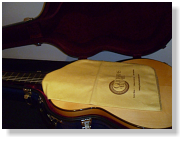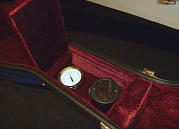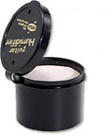On the request of friends and customers, we have prepared a series of tips and recommendations to travel with your guitar.
Car Travel:
• For safety reasons, the guitar should travel in the boot. In hot days, the guitar should be inside the car, but only when we are driving, and with the air conditioning on. If we make a stop, we should leave the car parked in the shadow to prevent the temperature inside the car from increasing too much and damaging the guitar.
• Never leave the guitar exposed to the sun, even with the air conditioning on, as it could damage it considerably.
• Never leave the guitar in the in car --even in the shadow-- for a very long time with very high temperatures outside, as this could damage the glues/adhesives or even produce cracks on the wood.
• The guitar should travel without clattering. If kept inside a case, place many cloths between the guitar and the case, so that a light pressure is applied to the sides, preventing it from moving inside the case.
• If the case has an inner pocket, make sure it does not open during the trip by using a piece of scotch tape to avoid its contents from coming out and spreading inside the case (and scratching the guitar).You could also empty this pocket altogether.
Train Travel:
• All the car tips are applicable here. If we put the guitar case in an overhead compartment, we must check that no air conditioning nozzles are placed directly over the guitar. This could damage the guitar in long journeys. Usually, air conditionings have a very low humidity level, and so they dry out the wood.
• If you leave the guitar in the luggage rack of the train car, watch out for falls. You may think that it is safe and well placed, by check it periodically, as the train movements could cause it to slide and fall.
• In these luggage spaces, be also careful not to let anyone pile up their suitcases on your guitar. Excessive pressure on the case could transmit harmful pressures to the guitar. Only very high quality cases are prepared to bear high pressures.
• Finally, watch out for thieves: stops in platforms and crowded ascent and descent of passengers are good opportunities for those wanting to snatch what is not theirs.
Air Travel:
• Whenever possible we should travel with our guitar in the cabin. Many companies allow carrying musical instruments in the cabin; this includes standard-sized guitars.
• Check your airline policy. If it allows carrying your guitar with you in the cabin, print the rules so you can show them to the flight crew if necessary, as sometimes they are not sufficiently informed.
Below are some examples and links to airlines luggage policies:
Iberia: Allows carrying guitar in the cabin.
American Airlines: Allows carrying guitar in the cabin.
British Airways: Does Not allow carrying guitar in the cabin.
• If you are able to choose among different airlines, always fly with the airline that allows you to carry your guitar with you in the cabin.•When possible, choose a seat at the back part of the plane. Usually these passengers are the first to get on the plane, and so there are more chances you can find enough space for your guitar.
• If, due to company policy, the guitar must be checked in, make sure your guitar has a good hard, safe and resistant case. If you have a high-priced guitar, you can declare its value at the airline desk and for a small sum of money you can insure it against breakage and loss. • For long journeys with multiple connections you can insure your guitar independently from the air company, for a low price, and become sure that, in case of accident or loss, at least you will recover the guitar’s economic value.
• If you have to check in your guitar, and therefore it must travel in the luggage rack, slightly loosen the strings (one turn is enough); this will avoid excessive pressure on the guitar during the flight.
General Advice:
• The guitar should always travel in a case that offers good protection and insulation; it should not be exposed to sudden changes in temperature or to low humidity (never below 40%).
• Nowadays there are very reliable travel cases. Fiberglass cases are very good, and you can buy one from 175 €. Carbon fiber cases are more resistant, available from 275 €.
• You should introduce a humidifier and hygrometer set into the case. With this, you ensure to provide the right humidity level, while measuring it at all times. A set with both devices only costs 15 €, very little for so much care for your guitar.
• The humidity level inside the case should be between 50 and 65%.
• For journeys where there is a very marked weather change between the place of origin and destination, after you arrive you should leave the guitar in its case for a few hours so that it gradually adapts to the new weather.
• Never leave the guitar in areas close to heat sources or sudden temperature changes: exposed to the sun, next to a radiator, on a windowsill, next to air conditioning nozzles, in very wet places (over 75% humidity) or in excessively dry places (less than 30% humidity).







